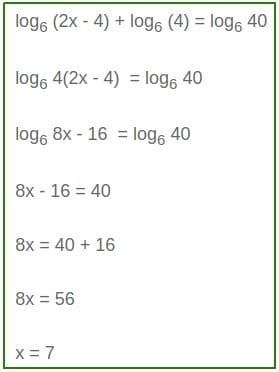Solve logarithmic equations
This lesson will discuss two ways to solve logarithmic equations. The method you use depends on the type of logarithmic equation you are trying to solve. Keep reading and you will learn how to solve the one below in a heartbeat!

The first type you will learn to solve has the following format
logb X = Y
To solve it, you just have to write it in exponential form as X = bY
Example #1
log (2x + 1) = 3
log10 (2x + 1) = 3
After writing it in exponential form we get
2x + 1 = 103
2x + 1 = 1000
2x = 999
x = 499.5
Check x = 499.5
log10 (2 x 499.5 + 1) = log10 (1000) = 3 since 103 = 1000
Sometimes when you solve logarithmic equations, you need to put all the logarithms on one side of the equation. Example #2 shows how to do this.
Example #2
log5 (30x - 10) - 2 = log5 (x + 6)
You can solve this one the same way you solved example #1.
Start by putting all logarithms on one side of the equation.
log5 (30x - 10) - log5 (x + 6) - 2 = log5 (x + 6) - log5 (x + 6)
log5 (30x - 10) - log5 (x + 6) -2 = 0
log5 (30x - 10) - log5 (x + 6) -2 + 2 = 0 + 2
log5 (30x - 10) - log5 (x + 6) = 2
log5 [ (30x - 10) / (x + 6) ] = 2
Now that it has the format that we want, we can just write it in exponential form.
30x - 10 / x + 6 = 52
30x - 10 / x + 6 = 25 ( After multiplying both sides by x + 6 )
30x - 10 = 25 (x + 6)
30x - 10 = 25x + 150
30x - 25x = 150 + 10
5x = 160
x = 32
Check x = 32
log5 (30x - 10) - 2 = log5 (x + 6)
log5 (30 x 32 - 10) - 2 = log5 (32 + 6)
log5 (960 - 10) - 2 = log5 (32 + 6)
log5 (950) - 2 = log5 (38)
4.26 - 2 = 2.26
2.26 = 2.26
x = 32 is a good answer.
Now, you will learn how to solve logarithmic equations that have the following format
logb X = logb Y
To solve it, you just have to see that logb X = logb Y if and only if X = Y
More examples showing how to solve logarithmic equations using logarithmic properties.
Example #3
log6 (2x - 4) + log6 (4) = log6 40
log6 4(2x - 4) = log6 40
log6 8x - 16 = log6 40
8x - 16 = 40
8x = 40 + 16
8x = 56
x = 7
Check x = 7
log6 (2 x 7 - 4) + log6 (4) = log6 40
log6 (14 - 4) + log6 (4) = log6 40
log6 (10) + log6 (4) = log6 40
log6 (10 x 4) = log6 40
log6 (40) = log6 40
x is 7 is a good answer.
Solve logarithmic equations with extraneous solutions
Example #4
log3 x + log3 (x + 3) = log3 (2x + 6)
log3 x(x + 3) = log3 (2x + 6)
log3 (x2 + 3x) = log3 (2x + 6)
x2 + 3x = 2x + 6
x2 + 3x - 2x - 6 = 0
x2 + x - 6 = 0
(x - 2) (x + 3) = 0
x = 2 and x = -3
Check x = 2
log3 2 + log3 (2 + 3) = log3 (2 x 2 + 6)
log3 2 + log3 (5) = log3 (4 + 6)
log3 2(5) = log3 (4 + 6)
log3 (10) = log3 (10)
x = 2 is a good answer.
Check x = -3
log3 -3 + log3 (-3 + 3) = log3 (2 x -3 + 6)
log3 -3 + log3 0 = log3 0
Since log3 -3 does not exist, x = -3 cannot be an answer. It is an extraneous solution.
Example #5
log (x + 2) + log (x - 1) = 1
Use the product rule to rewrite the left side of the equation
log [(x + 2)×(x - 1)] = 1
log [(x2 - x + 2x - 2 )] = 1
log [(x2 + x - 2 )] = 1
Notice that log10 10 = 1 since 101 = 10
log10 [(x2 + x - 2 )] = log10 10
x2 + x - 2 = 10
x2 + x - 2 - 10 = 10 - 10
x2 + x - 12 = 0
(x + 4)(x - 3) = 0
x = -4 and x = 3
Replace x = -4 and x = 3 into the original logarithmic equation to find the solution(s)
Check x = -4
log (x + 2) + log (x - 1) = 1
log (-4 + 2) + log (-4 - 1) = 1
log (-2) + log (-5) = 1
log (-2) and log (-5) do not exist since the logarithm of a negative number does not exist.
Therefore, x = -4 is an extraneous solution.
Check x = 3
log (x + 2) + log (x - 1) = 1
log (3 + 2) + log (3 - 1) = 1
log (5) + log (2) = 1
log(5×2) = 1
log 10 = 1
log10 10 = 1
Since log10 10 = 1 is a true statement, x = 3 is a solution.